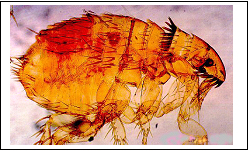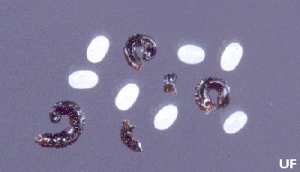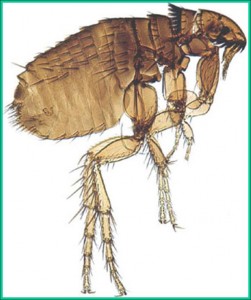
Cat Flea
Cat Flea (Ctenocephalides felis)
The cat flea is the most commonly encountered flea species in Michigan. The dog flea, Ctenocephalides canis, is usually found on wild animals, rather than on domestic pets. Both species prefer dogs and cats as hosts but they are found on a wide variety of other animal including rodents and livestock, which helps explain why some people who do not keep pets in their homes experience flea problems. Both species are intermediate hosts of the dog tapeworm that is common in both dogs and cats. The tapeworm is transmitted when the animal ingests infested fleas. This tapeworm may infect children if they accidentally ingest infested fleas. While cat and dog fleas prefer non-human hosts, they will feed readily on humans when infestations are heavy or when non-human host is not available. Like female mosquitoes, fleas have pierce-sucking mouthparts that enable the flea to suck blood from its host. Adult fleas are wingless but their powerful legs enable them to jump considerable distances.
Under ideal conditions (hot and humid weather) cat fleas can complete a life cycle in as little time as three weeks, however this development time is extended to several months under less than ideal conditions. Eggs are usually laid on the host and fall off as the animal moves about. Most eggs hatch in 7-14 days but under ideal conditions they may hatch in little as 2 days. Flea larvae are small, active, maggot-like creatures. They can feed on all sorts of organic debris, but they require at least some adult feces, which is essentially dried blood, to complete their development. The larval stages are passed in about a week, or up to several months, depending on environmental conditions and food availability. A mature flea larva measures about 1/16-1/8 of inch long and about 1/64 of an inch wide so it is no wonder that they are rarely seen. When mature, the larva spins a cocoon that becomes camouflaged with lint and other debris that sticks to it. Most fleas emerge from the pupa in 7-14 days, but some may not emerge for several months to a year later. These dormant or fleas “in waiting” represent an important survival strategy of fleas because they do not emerge until triggered by some event that signals the presence of a potential host. Warm and humid weather, the presence of carbon dioxide exhaled from a warm blooded animal, or mechanical signals such as vibrations from nearby footsteps or the weight of an animal actually stepping the cocoon will trigger emergence. This behavior can result in unwelcomed swarms of hungry fleas greeting returning vacationers or people who have just moved into a home or apartment. NO INSECTICIDE TREATMENT WILL KILL FLEA PUPAE.
An effective flea management in and around homes requires a carefully organized and executed program. Begin by inspecting the premises for areas that harbor large numbers of adult fleas. Put on a pair of white, calf-length socks and walk around the house and keep track of the areas where the most number of fleas are observed on the socks. Don’t forget closets and other out of the way places where cats like to spend time. These high concentration areas will require the most thorough treatment. Fleas will generally be most numerous in pet resting areas and other areas where the pet frequents because these areas receive the greatest amount of adult feces falling off the pet. Cat fleas do not voluntarily leave their host once they have hopped aboard, so the fleas observed on the socks will most likely be newly emerged adults seeking a host. Also, keep in mind that both dogs and cats are very effective flea removers. One researcher reports that up to 80% of the fleas are removed by the host in two weeks time. This should indicate that the focus of any flea control program is the environment where the pet lives and not the pet itself. The emphasis of an effective flea control program must be the environment where the flea larvae develop.
The cornerstone of preventing the development of flea larvae is a group of insecticides known as insect growth regulators, or IGRs. IGRs are synthetic copies of substances that are present in developing insects and control the growth of the larvae. At high concentrations, IGR’s actually interfere with normal development and eventually kill the larvae. Synthetic IGRs have extremely low mammalian toxicity so they are very safe to use around infants and small children. The most widely available IGR for flea control is product called methoprene. Precor remains effective for up to four months, so treating the home three times a year will virtually eliminate flea problems if the material is thoroughly applied. Precor is available at most large pet supplies stores, or at your veterinarian. Before applying Precor, the home should be thoroughly cleaned and vacuumed to remove any debris that will prevent complete coverage of Precor. After cleaning, apply the Precor spray to all floor surfaces, upholstered furniture (remove cushions and the interior areas), pet sleeping areas, and the bottom 18″ of floor length drapes. Be sure to move and treat under all furniture. Complete coverage is essential for Precor to be effective. Make sure all treated surfaces are completely dry, normally after 2 hours, before allowing family members back into the home. Wait 2 days before vacuuming the carpets again to allow the Precor time to “set up”.
Precor does not kill pupae or adult fleas so it is often mixed with another insecticide that will kill adult fleas. Adult fleas may continue to be a problem after the Precor is applied because of adults emerging from pupae that were present before the application of Precor. Several insecticides are registered for adult flea control in homes, however, some of these products maybe too harsh for infants and small children. The safest products that will kill the adult fleas are the household aerosols that contain pyrethrins, like Raid. Although safe, the one drawback in using pyrethrins is that these sprays only remain effective for one or two days, and re-treatment every other day may be required for complete control of newly emerging fleas. Household formulations of cyfluthrin (sold as Bayer Advanced Insect Control) provides residual control, that is, it remains effective for 2-3 weeks, but this can only be applied as a spot treatment and is not registered for a complete home treatment. Also, this material is a relatively strong insecticide, and I would not use it in my home if I had small children crawling about on the floor.
Be sure to read and follow all instructions and safety precautions listed on any pesticide label before using the pesticide.






 Print
Print Email
Email




